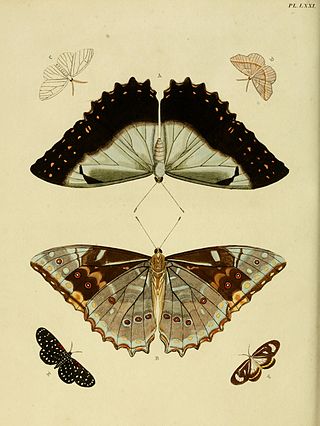
Oenosandridae is a family of Australian noctuoid moths. Genera include:

Notodontidae is a family of moths with approximately 3,800 known species. The family was described by James Francis Stephens in 1829. Moths of this family are found in all parts of the world, but they are most concentrated in tropical areas, especially in the New World.

Noctuoidea is the superfamily of noctuid or "owlet" moths, and has more than 70,000 described species, the largest number of any Lepidopteran superfamily. Its classification has not yet reached a satisfactory or stable state. Since the end of the 20th century, increasing availability of molecular phylogenetic data for this hugely successful radiation has led to several competing proposals for a taxonomic arrangement that correctly represents the relationships between the major lineages.

Stauropus alternus, the lobster caterpillar, lobster moth or crab caterpillar, is a moth of the family Notodontidae. It is found in the north-eastern Himalaya, Sri Lanka, Sundaland, the Philippines, Sulawesi and the southern Moluccas. It was described by Francis Walker in 1855.

Erbessa mimica is a moth of the family Notodontidae first described by Hering in 1925. It is found in Bolivia. The life expectancy of the moth is around 60 to 90 days.

Dioptinae is a subfamily of the moth family Notodontidae.
Anticoreura is a monotypic moth genus of the family Notodontidae described by Prout in 1918. Its one species, Anticoreura salmoni, first described by Herbert Druce in 1885, is found in Colombia.
Cacolyces is a monotypic moth genus of the family Notodontidae described by Warren in 1906. It consists of only one species, Cacolyces plagifera, first described by Francis Walker in 1856, which is found in Brazil, Venezuela, Guyana, Suriname and French Guiana.
Oricia is a genus of moths of the family Notodontidae. It was described in 1854 by English entomologist Francis Walker and contains four species distributed in Central and South America.
Phaeochlaena gyon is a moth of the family Notodontidae first described by Johan Christian Fabricius in 1787. It is endemic to the Guyana Shield and points west, at least as far as the Upper Amazon basin of Colombia and Ecuador.
Brachyglene crocearia is a moth of the family Notodontidae first described by William Schaus in 1912. It is found in Costa Rica, Honduras and Guatemala.
Nebulosa erymas is a moth of the family Notodontidae first described by Herbert Druce in 1885. It is found in Panama and Costa Rica.

Dioptis meon is a moth of the family Notodontidae first described by Pieter Cramer in 1775. It is found in Guyana and Suriname.
Euchontha frigida is a moth of the family Notodontidae first described by Francis Walker in 1864. It is distributed along the eastern slope of the Andes from central Colombia south to Bolivia.
Isostyla picata is a moth of the family Notodontidae first described by William Warren in 1900. It is found in Colombia and Ecuador.
Isostyla zetila is a moth of the family Notodontidae first described by Jean Baptiste Boisduval in 1870. It is found from Costa Rica north to Guatemala.

Dunama is a genus of moths of the family Notodontidae described by William Schaus in 1912.
Astapa is a Neotropical genus of moths of the family Notodontidae, with three described, and possibly several further not yet described, species. Species are known from Colombia, French Guiana and Ecuador.
Nystaleinae is a subfamily of the moth family Notodontidae. The subfamily was described by William Trowbridge Merrifield Forbes in 1948.

Heterocampinae is a subfamily of prominent moths in the family Notodontidae. There are at least 60 described species of Heterocampinae in North America.









